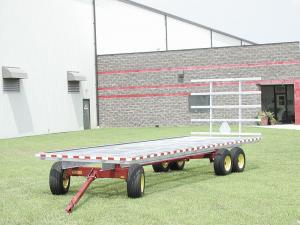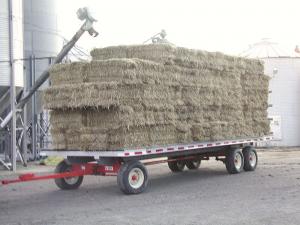2005 - Volume #29, Issue #6, Page #18
[ Sample Stories From This Issue | List of All Stories In This Issue | Print this story
| Read this issue]
All-Steel "Lifetime Wagon Bed"
 |
 |
The all-steel wagon beds come with an expanded metal grating floor, stake pockets, and a removable back panel. They're designed to bolt onto any standard running gear.
"Our wagon beds come with a standard 1-year unlimited manufacturer's warranty, but one look at them and it's obvious you'll never wear them out," says Nause, who farms near Blanchester, Ohio. "We're trying to help the farmer who has an old wooden wagon with a bed that needs to be replaced, but with a running gear that's still good. Our beds are many times stronger than conventional wooden beds so they have a lot more capacity."
The beds measure 8 ft. 4 in. wide and are available in lengths from 14 to 30 ft. They're built entirely from structural steel, with a hot dipped galvanized coating that won't rust. The frame is made from 3/8 by 2 1/2-in. steel flat bar, with tie down/rub rails on three sides and stake pockets on front and both sides of the bed. The bed is supported by 3-in. channel cross members, with 6-in. channel side rails and 8-in. sills.
A rear hitch, reflective tape, and a wooden floor are optional.
"These wagon beds are ideal for use with small or large square bales as well as small or large round bales. The expanded metal floor eliminates chaff build-up and allows ventilation from underneath to enhance drying while loaded. If you don't unload the hay right away, it won't mold. Also, the expanded metal floor helps secure the load and prevents it from shifting.
"However, these wagon beds also work great for hauling big water tanks, fertilizer tanks, and bulk seed tanks," says Nause. "The bed can easily support two 1,000-gal. tanks. We sell a lot of beds to tobacco farmers who use them to harvest tobacco.
"We've made these beds for 12 years but until now we've sold them mostly just in our local area. We started putting steel rails under wooden beds, and from there we went on to develop the all-steel bed."
Why is there a need for a new kind of wagon bed? One reason, says Nause, is that farmers have switched to round bales and also to bale accumulators for small square bales. "With accumulators you're able to load hay faster so you need more capacity. Conventional wooden wagon beds are much smaller and therefore have overload problems. Our 25-ft. bed can haul up to 315 32-in. small bales at a time. To go from point A to point B takes the same time whether you're pulling a wagon loaded with 110 bales or 315 bales.
"At shows, a lot of farmers come up to us and say it's about time someone updated the way wagon beds are designed. Old timers have asked us, where were you guys 40 years ago when we needed you? They know you're lucky if you can get six or eight years out of most wooden wagon beds before the wood starts rotting and warping. To make them last longer than that you've got to work on them a lot, repairing rotten wood and patching holes, etc. On the other hand, you can let our galvanized steel wagon bed sit outside all year long and it'll never rust."
If you don't have a running gear, Nause says he can supply them.
A 20-ft. model without running gear sells for $3,000; a 25-ft. model sells for $3,750. Running gears are available at competitive prices. Nause is looking for dealers.
Contact: FARM SHOW Followup, G.L. Nause Co., Inc., 1971 Phoenix Drive, Loveland, Ohio 45140 (ph 513 722-9500; gnause@fuse.net; www.GLNause.com).

Click here to download page story appeared in.

Click here to read entire issue
To read the rest of this story, download this issue below or click here to register with your account number.




